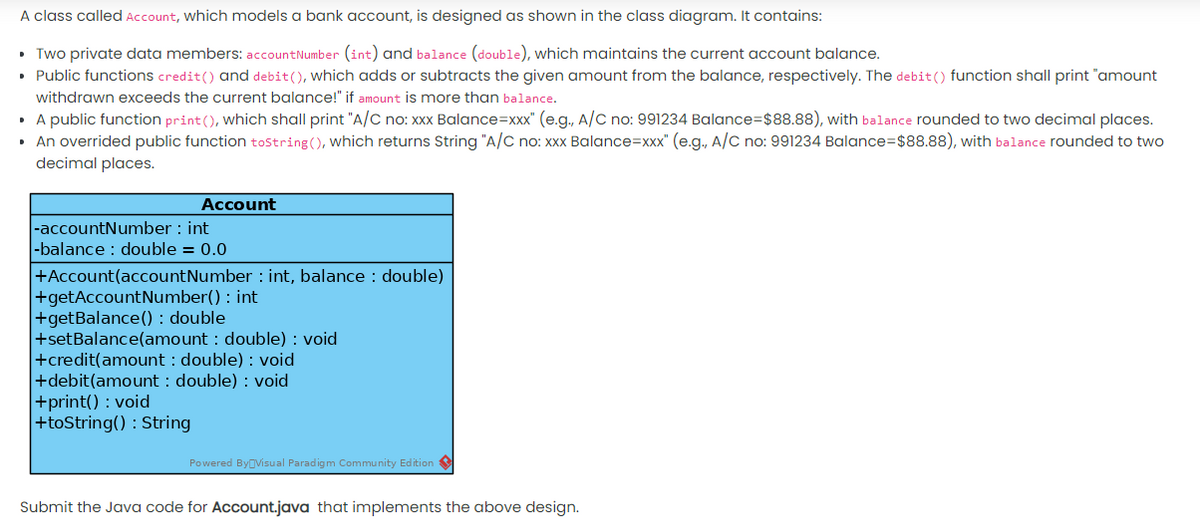A class called Account, which models a bank account, is designed as shown in the class diagram. It contains: • Two private data members: accountNumber (int) and balance (double), which maintains the current account balance. • Public functions credit() and debit(), which adds or subtracts the given amount from the balance, respectively. The debit() function shall print "amount withdrawn exceeds the current balance!" if amount is more than balance. • A public function print(), Which shall print "A/C no: xxx Balance=xxx" (e.g., A/C no: 991234 Balance=$88.88), with balance rounded to two decimal places. • An overrided public function tostring(), which returns String "A/C no: xxx Balance=xxx" (e.g., A/C no: 991234 Balance=$88.88), with balance rounded to two decimal places. Account |-accountNumber : int |-balance : double = 0.0 +Account(accountNumber : int, balance : double) +getAccountNumber() : int +getBalance() : double +setBalance(amount : double) : void +credit(amount : double) : void +debit(amount : double) : void +print() : void +toString() : String Powered ByOVisual Paradigm Community Edition Submit the Java code for Account.java that implements the above design.
A class called Account, which models a bank account, is designed as shown in the class diagram. It contains: • Two private data members: accountNumber (int) and balance (double), which maintains the current account balance. • Public functions credit() and debit(), which adds or subtracts the given amount from the balance, respectively. The debit() function shall print "amount withdrawn exceeds the current balance!" if amount is more than balance. • A public function print(), Which shall print "A/C no: xxx Balance=xxx" (e.g., A/C no: 991234 Balance=$88.88), with balance rounded to two decimal places. • An overrided public function tostring(), which returns String "A/C no: xxx Balance=xxx" (e.g., A/C no: 991234 Balance=$88.88), with balance rounded to two decimal places. Account |-accountNumber : int |-balance : double = 0.0 +Account(accountNumber : int, balance : double) +getAccountNumber() : int +getBalance() : double +setBalance(amount : double) : void +credit(amount : double) : void +debit(amount : double) : void +print() : void +toString() : String Powered ByOVisual Paradigm Community Edition Submit the Java code for Account.java that implements the above design.
C++ Programming: From Problem Analysis to Program Design
8th Edition
ISBN:9781337102087
Author:D. S. Malik
Publisher:D. S. Malik
Chapter10: Classes And Data Abstraction
Section: Chapter Questions
Problem 7SA: Assume the definition of class foodType as given in Exercise 6. Answer the following questions? (1,...
Related questions
Question
Write a Java code

Transcribed Image Text:A class called Account, which models a bank account, is designed as shown in the class diagram. It contains:
• Two private data members: accountNumber (int) and balance (double), which maintains the current account balance.
• Public functions credit() and debit(), which adds or subtracts the given amount from the balance, respectively. The debit() function shall print "amount
withdrawn exceeds the current balance!" if amount is more than balance.
• A public function print(), Which shall print "A/C no: xxx Balance=xxx" (e.g., A/C no: 991234 Balance=$88.88), with balance rounded to two decimal places.
• An overrided public function tostring(), which returns String "A/C no: xxx Balance=xxx" (e.g., A/C no: 991234 Balance=$88.88), with balance rounded to two
decimal places.
Account
|-accountNumber : int
|-balance : double = 0.0
+Account(accountNumber : int, balance : double)
+getAccountNumber() : int
+getBalance() : double
+setBalance(amount : double) : void
+credit(amount : double) : void
+debit(amount : double) : void
+print() : void
+toString() : String
Powered ByOVisual Paradigm Community Edition
Submit the Java code for Account.java that implements the above design.
Expert Solution
This question has been solved!
Explore an expertly crafted, step-by-step solution for a thorough understanding of key concepts.
This is a popular solution!
Trending now
This is a popular solution!
Step by step
Solved in 2 steps with 1 images

Knowledge Booster
Learn more about
Need a deep-dive on the concept behind this application? Look no further. Learn more about this topic, computer-science and related others by exploring similar questions and additional content below.Recommended textbooks for you

C++ Programming: From Problem Analysis to Program…
Computer Science
ISBN:
9781337102087
Author:
D. S. Malik
Publisher:
Cengage Learning

C++ for Engineers and Scientists
Computer Science
ISBN:
9781133187844
Author:
Bronson, Gary J.
Publisher:
Course Technology Ptr

C++ Programming: From Problem Analysis to Program…
Computer Science
ISBN:
9781337102087
Author:
D. S. Malik
Publisher:
Cengage Learning

C++ for Engineers and Scientists
Computer Science
ISBN:
9781133187844
Author:
Bronson, Gary J.
Publisher:
Course Technology Ptr